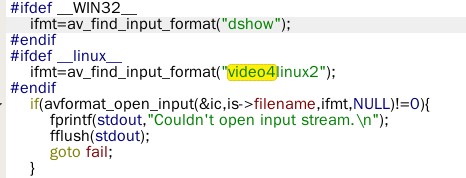
- LINUX FFMPEG DEV EXAMPLES HOW TO
- LINUX FFMPEG DEV EXAMPLES INSTALL
- LINUX FFMPEG DEV EXAMPLES UPDATE
- LINUX FFMPEG DEV EXAMPLES FULL
- LINUX FFMPEG DEV EXAMPLES CODE
LINUX FFMPEG DEV EXAMPLES CODE
slang code Set the ISO 639 language code (3 letters) of the current subtitle stream. newsubtitle Add a new subtitle stream to the current output stream. scodec codec Force subtitle codec ('copy' to copy stream). All the format options (bitrate, codecs, buffer sizes) are thenįfmpeg -i myfile.avi -target vcd /tmp/vcd.mpgNevertheless you can specify additional options as long as you know they do not conflict with the standard, as in:įfmpeg -i myfile.avi -target vcd -bf 2 /tmp/vcd.mpg -dframes number Set the number of data frames to record. target type Specify target file type ("vcd", "svcd", "dvd", "dv", "dv50", "pal-vcd", "ntsc-svcd". metadata key = value Set a metadata key/value pair.įor example, for setting the title in the output file:įfmpeg -i in.avi -metadata title="my title" out.flv -v number Set the logging verbosity level. Specifying a positive offset means that the corresponding streams are delayed by 'offset' Offset is added to the timestamps of the input files. This option affects all the input files that follow it. itsoffset offset Set the input time offset in seconds. ss position Seek to given time position in seconds. t duration Restrict the transcoded/captured video sequence to the duration specified in seconds. Quiet panic fatal error warning info verbose debug loglevel is a number or a string containing one of the following values: loglevel loglevel Set the logging level used by the library. filters Show available libavfilter filters. The fields preceding the codec names have the following meanings:Ĭodec can handle input truncated at random locations instead of only at frame boundaries The fields preceding the format names have the following meanings: Each flavor of Linux – Ubuntu, Arch Linux, Debian, CentOS/RHEL, Fedora – have slight differences when installing FFmpeg.Generic options These options are shared amongst the ff* tools. Just log in as a root user and follow the guidelines for your OS. Installing FFmpeg on a Linux machine is easy, and takes only a few minutes. To verify the installation, execute: ffmpeg -version Conclusion
LINUX FFMPEG DEV EXAMPLES UPDATE
To reflect these changes, update the system using: pacman -SuĪnd you’re done! FFmpeg should be successfully added to your Arch Linux machine.
LINUX FFMPEG DEV EXAMPLES INSTALL
Next, we can install FFmpeg using: pacman -R ffmpeg4.0 To update the DB, we can use the following command: pacman -Sy vlc The official repository will give details of which version is available.
LINUX FFMPEG DEV EXAMPLES HOW TO
How to Install FFmpeg on Arch Linuxįor Arch Linux, we need to use the Pacman package manager. That’s it, you successfully added FFmpeg to your Fedora virtual machine. Next, we can install FFmpeg and its development package using a DNF package manager. If you don’t have it installed use this command: dnf install $(rpm -E %fedora).noarch.rpm dnf install $(rpm -E %fedora).noarch.rpm To install FFmpeg on Fedora, use the RPMfusion repository. Next, we can install FFmpeg and its development packages using: yum install ffmpeg ffmpeg-devel -y On CentOS/RHEL 6/5, the command is slightly different and refers to a different repository.

On CentOS 7 and RHEL 7 use the following command: rpm -import rpm -Uvh To install using CentOS 7 or 6, update the system using: yum install epel-release -y yum update -y This can be installed using third-party nux dextop yum repo. To validate the installation on Debian, use the following command: ffmpeg -version How to Install FFmpeg on CentOS, Fedora, and RHELĬentOS does not provide an official repository for FFmpeg installation. Once you’re done, install the FFmpeg package using: apt install ffmpeg apt update apt install deb-multimedia-keyring apt update

This makes sure that all the changes are correctly updated and noted. First, we will update, then install, and update one more time. Next we will have to install the deb-multimedia-keyring package. To save your edit on the vi editor press Esc. To exit the editor press : and execute q! Open the file using the following command and press I (Insert) to start editing: vi /etc/apt/sources.listĪdd the lines listed below to the file: deb jessie main non-free To edit this file, you can use a terminal editor such as nano or vi.

This file contains the list of repositories APT uses. To add this, we need to edit the file /etc/apt/sources.list. We will have to add the Debian multimedia repository. However, the Debian multimedia repository can be used to install the codex. If you’re using Debian 8 – Jessie, FFmpeg won’t be available in the official repository. It’s available in the official Debian repository.įirst, update the package list using: apt updateĪfter this we can execute the following command to install FFmpeg: apt install ffmpeg

The FFmpeg package uses the apt package manager for installation. To install FFmpeg on Debian 9 – Stretch, you need to be logged in as a root user. 30-day money back guarantee - no questions asked! Get Yours Today How to Install FFmpeg on Debian
LINUX FFMPEG DEV EXAMPLES FULL
Take full control with Hostinger VPS plans.


 0 kommentar(er)
0 kommentar(er)
